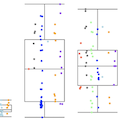Abstract
Baloxavir Marboxil (BXM) is an influenza polymerase inhibitor antiviral that binds to the endonuclease region in the PA subunit of influenza A and B viruses. To establish the baseline susceptibility of viruses circulating prior to licensure of BXM and to monitor for susceptibility post-BXM use, a cell culture-based focus reduction assay was developed to determine the susceptibility of 286 circulating seasonal influenza viruses, A(H1N1)pdm09, A(H3N2), B (Yamagata/Victoria) lineage viruses, including neuraminidase inhibitor (NAI) resistant viruses, to Baloxavir Acid (BXA), the active metabolic form of BXM. BXA was effective against all influenza subtypes tested with mean EC50 values (minimum-maximum) of 0.7 ± 0.5 nM (0.1–2.1 nM), 1.2 ± 0.6 nM (0.1–2.4), 7.2 ± 3.5 nM (0.7–14.8), and 5.8 ± 4.5 nM (1.8–15.5) obtained for A(H1N1)pdm09, A(H3N2), B(Victoria lineage), and B(Yamagata lineage) influenza viruses, respectively. Using reverse genetics, amino acid substitutions known to alter BXA susceptibility were introduced into the PA protein resulting in EC50 fold change increases that ranged from 2 to 65. Our study demonstrates that currently circulating viruses are susceptible to BXA and that the newly developed focus reduction assay is well suited to susceptibility monitoring in reference laboratories.
